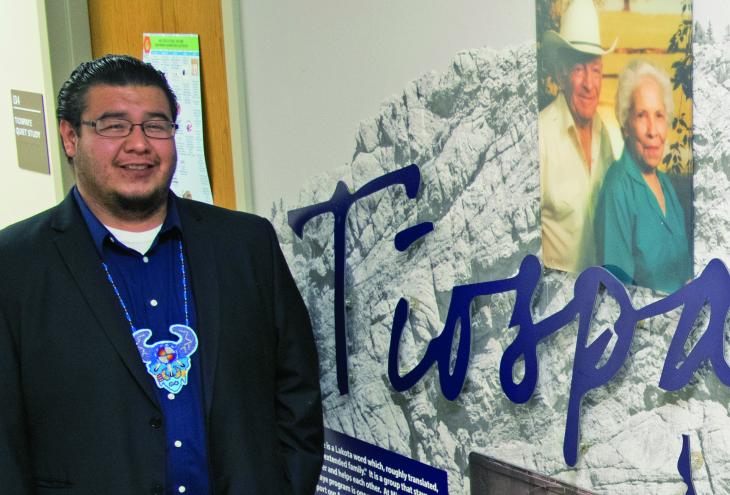Adonis Martinez spent his childhood at the foot of the Black Hills in Rapid City, S.D. He was raised by his grandparents and great-grandparents in a family that has emphasized education for generations. His great-grandmother and grandmother both attended college, encouraged by their families. Growing up, Martinez was told, “You either go to school or you work. There is no in-between.”
Martinez, Cheyenne River Sioux, has come to believe that communities often come together through commonalities — whether these commonalities are cultural, hereditary, or geographic, we are part of multiple communities. That connection to community inspired him to take on leadership roles from an early age.
In high school Martinez was one of two student representatives for a Title VII Indian Education Formula Grant in the Rapid City Area School District. In college, at the South Dakota School of Mines and Technology (SDSMT), he quickly became involved in the AISES chapter, where he served as secretary, vice president, and president. He also became a fellow of Rapid City Collective Impact, a cadre of emerging leaders who share the goal of improving the quality of life in Rapid City. “I didn’t do these things for my resume,” Martinez says. “I didn’t do them for the title. I did them because it was the right thing.”
His path to college took many turns, but early on Martinez saw himself at SDSMT. When it came time to apply, he was concerned that he didn’t have the grades. “I was lazy my first couple of years of high school,” he explains. “I didn’t go to class and I didn’t have the GPA required, so I was nervous.” But thanks to a high ACT score and his math and science classes, Martinez was ultimately accepted to his dream school.
Encouraged by his professors, Martinez quickly chose civil engineering as his major. In his freshman year, he interned with the U.S. Geological Survey (USGS), where he served as a “student in support of Native American relations” helping to monitor shoreline erosion on the Lower Brule Reservation. “This project showed me how I could have an impact in Native American communities as an engineer,” he says. Martinez continued to work for the USGS during college as a student trainee in hydrology, participating in projects for the Lower Brule Sioux, Standing Rock Sioux, and Cheyenne River Sioux Tribes.
One of the biggest lessons Martinez has learned is that because community members know what they need most, they should be involved in all aspects of project planning.
In 2017 Martinez graduated with his BS in civil engineering. Instead of pursing the traditional engineering path, he chose to serve his community and applied to AmeriCorps VISTA (Volunteers in Service to America), whose members bring their passion to organizations that help eradicate poverty.
Martinez is now working with Oglala Sioux Lakota Housing in Pine Ridge, S.D., where, he says, housing is a big concern. As a VISTA member, he serves as the utilities/public works strategist and has given presentations on working effectively with tribal governments and cultural communication. During his six years in school, Martinez had observed project after project fail due to the lack of Native perspective. “A few years ago, there was an initiative to distribute precast concrete homes,” he says. “The price would have been around $27,000 for the entire home with options to customize layouts.”
Martinez recalls being excited about these homes because they could withstand hurricane-force winds and earthquakes. Unfortunately, the community saw little need for homes with this strength. “The lack of enthusiasm for this great opportunity told me that the communities need to be involved at the beginning of a project,” he explains. “The price of the homes was phenomenal, and talking with people could have illustrated that the strength of these precast homes was a secondary benefit when compared with the affordability.”
One of the biggest lessons Martinez has learned is that because community members know what they need most, they should be involved in all aspects of project planning. Being a VISTA member, he has had a chance to finally engage the communities he works with throughout design and implementation.
“There’s a recurring theme in all that I’ve done over the years,” he says. “I’ve always done community service in one way or another, so it was an easy decision to join AmeriCorps. As a VISTA member I serve as a catalyst for change, living and working alongside community members to advance local solutions. But whether it’s in your community or not, you can’t go wrong by being a VISTA member.”











